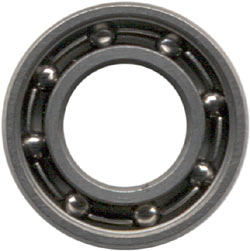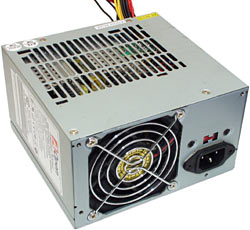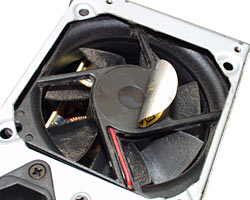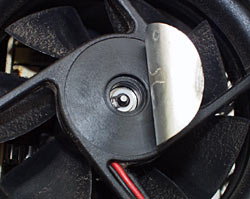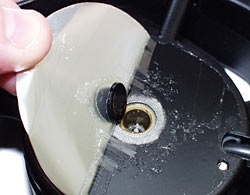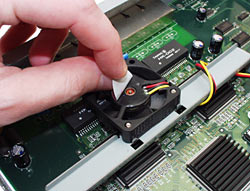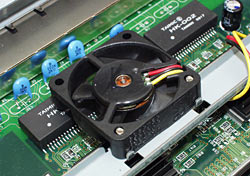
Fan maintenance
Originally published 2001 in Atomic: Maximum Power Computing Last modified 03-Dec-2011.
Your computer's life probably depends on fans. At least two, in pretty much all current PCs - a little fast one on the CPU cooler, and a bigger slower one in the power supply. Many PCs have a second 80mm fan mounted in the front of the case to help with air flow. And some... special... PCs have a veritable wind farm in there, competing for space with the neon lights and fluffy dice.
The trouble is - fans don't last forever.
The motors in modern computer fans are brushless units which will last, by computer standards, forever. But the spindle on which the fan turns sits in a bearing, and bearings wear out.
The most common, and cheapest, kind of fan bearing is the "sleeve" type. It's a simple design; the steel shaft just sits in a solid bushing. The bushing is likely to be made from sintered bronze, which is porous metal that's impregnated with lubricant at the factory. When that lubricant runs out, the bearing will start to wear, and make a distinctive buzz. The wear will get worse and worse, the buzz louder and louder, and the fan slower and slower, until finally it stops.
This process can take weeks for larger, slower fans, but can happen a lot faster to smaller, higher speed fans. A failed CPU cooler fan probably won't leave you with a dead CPU, but it will make your computer hopelessly flaky until it's replaced.
The other kind of bearing is the "ballrace", commonly just called a "ball bearing".
This is what a ballrace looks like on the inside - a ring of steel balls in the space between outer and inner rings of metal. The balls roll between the rings, allowing them to rotate freely.
Ballraces last better than cheap sleeve bearings; some higher-tech sleeve bearings now exist which may well outlast ball bearings, but most computer fans use the cheap type. When ball bearings finally do fail, though, they can seize rock solid. Once that happens, they're junk.
If you catch a deteriorating bearing before it gets too bad, though, you can make the fan live a lot longer with a few drops of oil. If you oil a bearing before it shows any symptoms, the thing can live for a lot longer than the manufacturers expected.
So how do you oil a fan bearing?
In almost all cases, it's actually quite easy.
First, you need to get access to the motor side of the fan, which will be covered by a sticker.
Most ATX Power Supply Units (PSUs), including this one, have their fan mounted so that you can see the sticker through the finger guard. Undo the four screws holding the finger guard in place (they also hold the fan in place, but it probably won't have much room to move even without them) and you can get at the sticker side of the fan without taking the lid off the PSU.
Now, carefully peel back the sticker. If you damage it, don't panic; you can just replace it with a piece of tape.
Small fans often seal the bearing with nothing but the sticker, but larger ones usually have a round plastic cap under the sticker. This fan's got a rubber cap, which is easy enough to pop out.
Inside, you can see the bearing. This fan's got a ball bearing; sleeve bearings are less interesting looking.
Now, oil that sucker.
What you oil it with isn't too critical. Pretty much any light oil will do. Plain old 3-IN-ONE or sewing machine oil from the supermarket is fine. Note that the usual red-label 3-IN-ONE that I'm using above has a vegetable oil base, and may gum things up if used over and over. This isn't likely to be a big problem with fan bearings (it's usually only an issue in automotive and other high temperature applications), but if you're concerned then you should get the blue-label mineral based version.
Spray-can oils with an applicator tube can be handy for oiling fans in awkward spots, if you can avoid spraying oil all over the place.
Do not, however, use WD-40 or similar products. WD-40 is has great penetration, displaces water well, and loosens rust - but it's a lousy lubricant. It's mainly kerosene, and the oil that's left when the kerosene evaporates may be more than adequate for stopping a gate-hinge from squeaking, but won't last long in a fan bearing.
Resist the urge to try to fill the bearing well completely with oil. If the fan isn't installed bearing-side-up, excess oil in the well will leak out rapidly, pretty much regardless of what you stick over the well. Even if the bearing side is upwards, centrifugal force when the fan's running will allow a surprising amount of the oil to escape.
(Yes, yes, I know that centrifugal force doesn't really exist.)
If you want to fill the well with oil and let the fan sit for a while, so the oil can permeate the bearing a bit, fine. But soak up the excess with something before you put the sticker back on, or you'll just make a mess. You'll probably also need to de-grease the plastic back of the fan, in order to get the sticker to adhere again.
The above instructions apply to pretty much every rotary fan you'll find in a PC - and they'll continue to, at least until things like these become popular.
Even large fans, like this 120mm mains powered unit, have the same bearing arrangement as much smaller models.
Apart from the danger of equipment failure caused by a dead fan, you can't always easily replace a fan if it fails. So it pays to keep unusual fans oiled.
This little fan, in a network switch, doesn't look all that weird. But it's actually a five volt unit, not the usual 12 volts, so it'd be difficult to replace.
